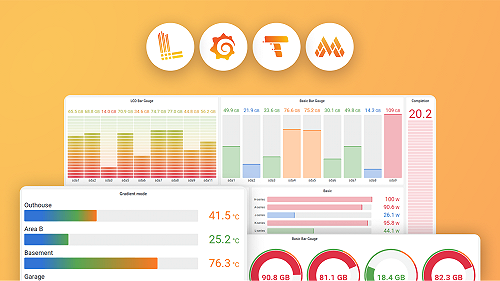This is documentation for the next version of Grafana. For the latest stable release, go to the latest version.
Import data source-managed alert rules with Grafana Mimirtool
You can convert data source–managed alert rules, such as Prometheus alert rules, to Grafana-managed alert rules using Grafana user interface or command-line tools. This guide shows you how to use the Grafana Mimirtool to import your data source-managed alert rules.
Before you begin
You need to have the Grafana Mimirtool command-line tool installed.
You need a service account with the following RBAC permissions:
- Alerting: Rules Reader
- Alerting: Rules Writer
- Alerting: Set provisioning status
- Datasources: Reader
- Folders: Creator
- Folders: Reader
- Folders: Writer
You also need to create a service account token with your service account. Refer to the documentation for more information on service accounts and service account tokens.
How it works
When you use the import tool, data source-managed rules are copied to another folder as Grafana-managed alert rules, preserving the behavior of the rules, and the original alert rules are kept in their original location.
When data source-managed alert rules are converted to Grafana-managed alert rules, the following are applied to the Grafana-managed alert rules:
- All rules are given
rule_query_offsetoffset value of 1m.
Grafana OSS and Enterprise can configure this value in their conf:If this value is set explicitly in a rule group, that value takes precedence over the configuration setting.[unified_alerting.prometheus_conversion] rule_query_offset = 1m - The
missing_series_evals_to_resolveis set to 1 for the new rules. - The newly created rules are given unique UIDs.
If you don’t want the UID to be automatically generated, you can specify a specific UID with the__grafana_alert_rule_uid__label.
Import alert rules with mimirtool or cortextool
You can use either
mimirtool or
cortextool (version 0.11.3 or later) to import data source–managed alert rules into Grafana as Grafana-managed alert rules.
mimirtool
To convert and import them into a Grafana instance, you can use the mimirtool rules load command:
MIMIR_ADDRESS=<GRAFANA_BASE_URL>/api/convert/ \
MIMIR_AUTH_TOKEN=<SERVICE_ACCOUNT_TOKEN> \
MIMIR_TENANT_ID=1 \
mimirtool rules load rule_file.yaml \
--extra-headers "X-Grafana-Alerting-Datasource-UID=<DATASOURCE_UID_QUERY_TARGET>"This command imports Prometheus alert rules defined in rule_file.yaml as Grafana-managed alert rules. It’s important to know that:
- When using the
<GRAFANA_BASE_URL>/api/convert/endpoint,mimirtoolinteracts with Grafana—not with a Mimir instance. In this case,MIMIR_TENANT_IDmust always be set to1. - The
X-Grafana-Alerting-Datasource-UIDheader configures the data source that the imported alert rules will query. Use multiple--extra-headersflags to include other optional headers.
Similarly, the rules sync command can import and update Grafana-managed alert rules.
MIMIR_ADDRESS=<GRAFANA_BASE_URL>/api/convert/ \
MIMIR_AUTH_TOKEN=<SERVICE_ACCOUNT_TOKEN> \
MIMIR_TENANT_ID=1 \
mimirtool rules sync rule_file.yaml \
--extra-headers "X-Grafana-Alerting-Datasource-UID=<DATASOURCE_UID_QUERY_TARGET>" \
--concurrency 1The --concurrency flag must be set to 1, as the default value of 8 may cause API errors.
This sync command reads rules from the file, compares them with the existing Grafana-managed rules in the instance, and applies only the differences—creating, updating, or deleting rules as needed.
## Sync Summary: 0 Groups Created, 1 Groups Updated, 0 Groups DeletedFor more information other Mimirtool commands and options, see the Mimirtool documentation and the Mimir HTTP Rule API documentation.
cortextool
For Loki alert rules, use
cortextool (version 0.11.3 or later) with the --backend=loki flag. For example:
CORTEX_ADDRESS=<GRAFANA_BASE_URL>/api/convert/ \
CORTEX_AUTH_TOKEN=<SERVICE_ACCOUNT_TOKEN> \
CORTEX_TENANT_ID=1 \
cortextool rules load loki_rules.yaml \
--extra-headers "X-Grafana-Alerting-Datasource-UID=<LOKI_DATASOURCE_UID_QUERY_TARGET>" \
--backend=lokiCompatible endpoints
The API endpoints listed in this section are supported in Grafana and are used by mimirtool and cortextool, as shown earlier.
The POST endpoints can be used to import data source–managed alert rules.
The GET and DELETE endpoints work only with provisioned and imported alert rules.
Optional Headers
Additional configuration headers for more granular import control include the following:
X-Disable-Provenance
When this header is set to true:
- The imported rules are not marked as provisioned.
- They can then be edited in the Grafana UI.
- They are excluded from the
GETandDELETEoperations on the/api/convertendpoints.
X-Grafana-Alerting-Alert-Rules-Paused
Set to “true” to import alert rules in paused state.
X-Grafana-Alerting-Recording-Rules-Paused
Set to “true” to import recording rules in paused state.
X-Grafana-Alerting-Datasource-UID
The UID of the data source to use for alert rule queries.
X-Grafana-Alerting-Target-Datasource-UID
The UID of the target data source for recording rules. If not specified, the value from X-Grafana-Alerting-Datasource-UID is used.
X-Grafana-Alerting-Folder-UID
Enter the UID of the target destination folder for imported rules.
X-Grafana-Alerting-Notification-Settings
JSON-encoded
AlertRuleNotificationSettings object that allows setting the contact point for the alert rules.
AlertRuleNotificationSettings object
When you set X-Grafana-Alerting-Notification-Settings, the header value must be a JSON-encoded object with the following keys:




